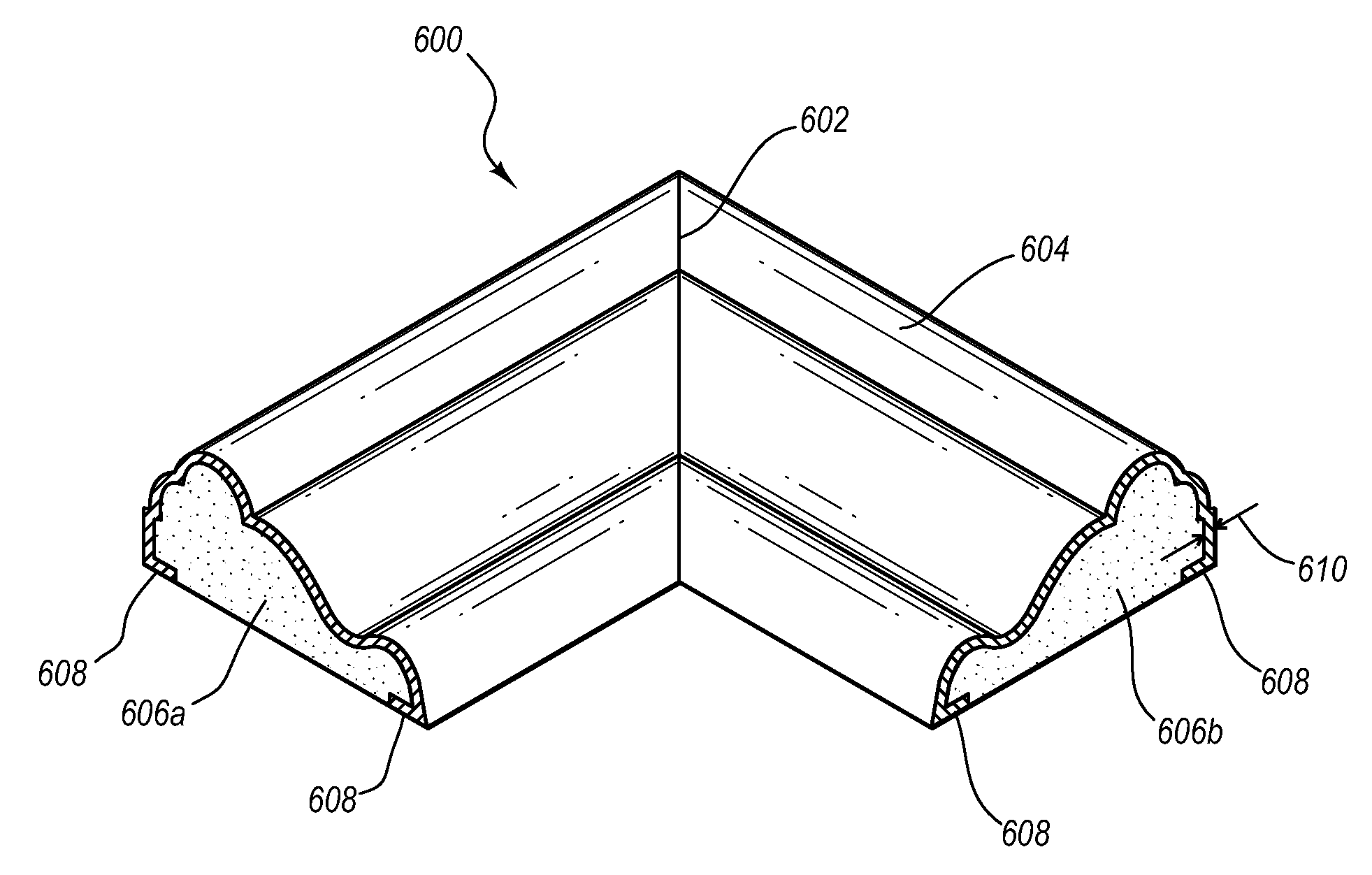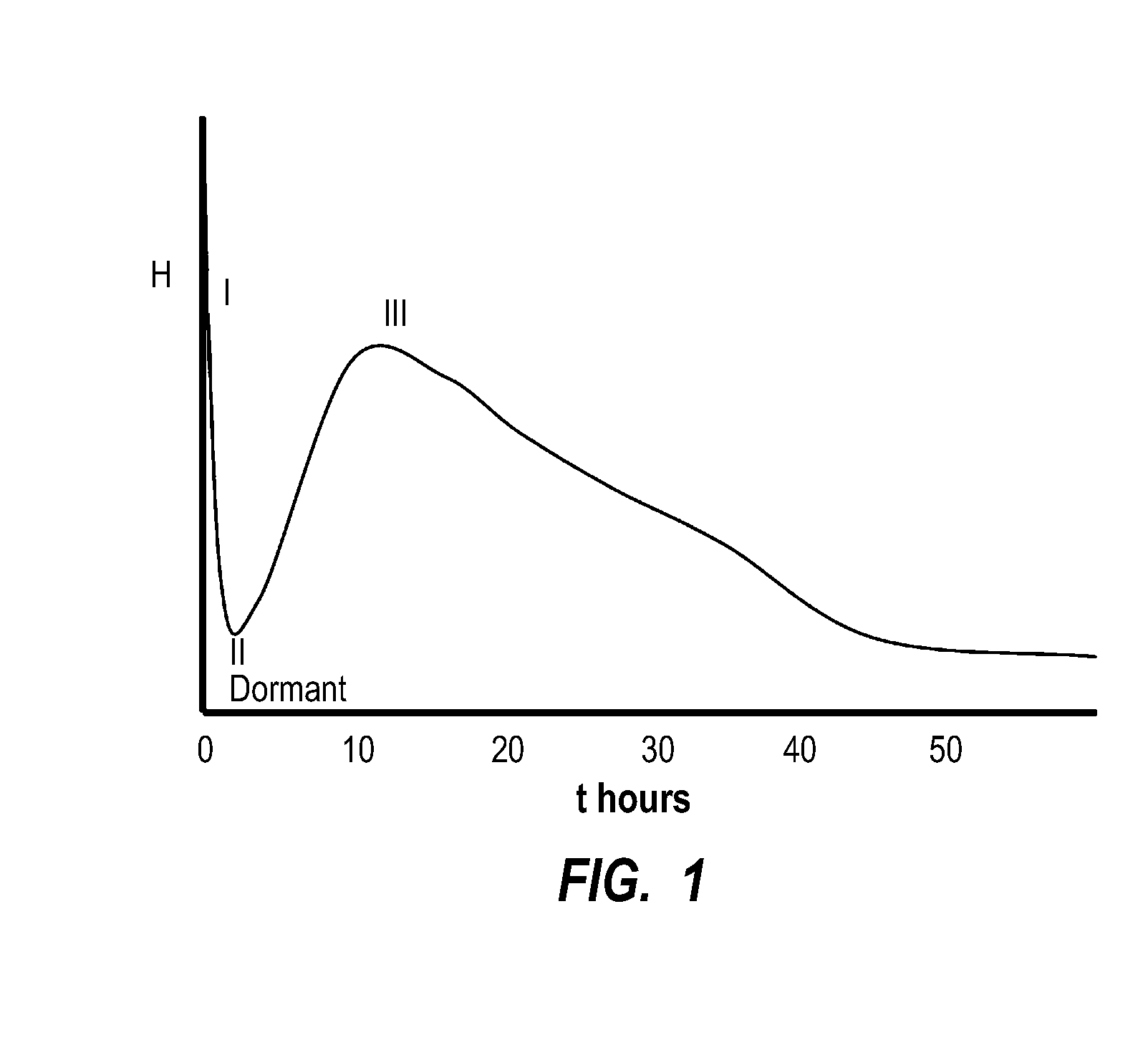Molded cementitious architectural products having a polished stone-like surface finish
- Summary
- Abstract
- Description
- Claims
- Application Information
AI Technical Summary
Benefits of technology
Problems solved by technology
Method used
Image
Examples
example 1
[0111]A wet cementitious mixture was prepared for use in manufacturing molded cementitious architectural products by mixing together the following components in the stated amounts (% means weight percent unless otherwise specified):
Water8.5 lb 14.3%Lehigh White Cement15 lb 25.2%Marble Mix21 lb 35.3%Specialty Minerals #9 Limestone9 lb15.1%Uniman Sand (90 grit)4 lb 6.7%AC-100 Acrylic Polymer1 lb 1.7%Wacker RE 5028 N Latex Polymer1 lb 1.7%PVA Fibers (20 g)0.04 lb 0.07%Colorvariable as specified
[0112]A portion of the water (30%) was initially blended with the aggregates (i.e., marble mix, limestone and sand) and the latex polymer within the mixing drum of a standard concrete mixer. After 15 seconds the color and fibers were added to the mixture, which was allowed to mix for a total of 3 minutes. Following the initial mixing sequence the mixing drum was scraped. Thereafter, the remaining water and the white cement were added proportionally to the mixing drum, followed by mixing for an ...
example 2
[0114]A wet cementitious mixture was prepared for use in manufacturing molded cementitious architectural products by mixing together the following components in the stated amounts (% means weight percent unless otherwise specified):
Arcustone ® Pre-bagged Concrete50 lb85.1%(exact contents unknown)Water7.75 lb 13.2%AC-100 Acrylic Polymer 1 lb 1.7%
[0115]A portion of the water (70%) was initially blended with the Arcustone, followed by the remainder (30%) of the water within the mixing drum of a standard concrete mixer for 3 minutes. Following the initial mixing sequence the mixing drum was scraped. Thereafter, the acrylic polymer was added to the mixing drum, followed by mixing for an additional 3 minutes to yield the wet cementitious material.
[0116]The wet cementitious material was used to manufacture various molded cementitious architectural products, including products similar to those illustrated in FIGS. 5-8. After reaching initial set but before final hardening, a portion of the...
example 3
[0117]A wet cementitious mixture was prepared for use in manufacturing molded cementitious architectural products by mixing together the following components in the stated amounts (% means weight percent unless otherwise specified):
Water12.5 lb 15.0%White Cement30 lb 36.1%Marble Mix21 lb 25.3%Specialty Minerals #9 Limestone9 lb10.8%Wacker RE 5028 N Latex Polymer1 lb 1.2%Sand (#60 420)8 lb 9.6%PVA Fibers (80 g)0.18 lb 0.022% Glenium (water reducer) (57 g)0.13 lb 0.016% Methocel (2 g)0 lb 0%Color (600 g)1.32 lb 1.6%
[0118]All the dry ingredients were placed in the mixing drum of a standard concrete mixer and mixed for 1 minute. A portion of the water (38%) was added to the mixing drum followed by mixing for 5 minutes. The remainder of the water and the Glenium were added and then mixed for 3 additional minute to yield the wet cementitious material.
[0119]The wet cementitious material was used to manufacture various molded cementitious architectural products, including products sim...
PUM
| Property | Measurement | Unit |
|---|---|---|
| Temperature | aaaaa | aaaaa |
| Temperature | aaaaa | aaaaa |
| Fraction | aaaaa | aaaaa |
Abstract
Description
Claims
Application Information
 Login to View More
Login to View More - R&D
- Intellectual Property
- Life Sciences
- Materials
- Tech Scout
- Unparalleled Data Quality
- Higher Quality Content
- 60% Fewer Hallucinations
Browse by: Latest US Patents, China's latest patents, Technical Efficacy Thesaurus, Application Domain, Technology Topic, Popular Technical Reports.
© 2025 PatSnap. All rights reserved.Legal|Privacy policy|Modern Slavery Act Transparency Statement|Sitemap|About US| Contact US: help@patsnap.com



